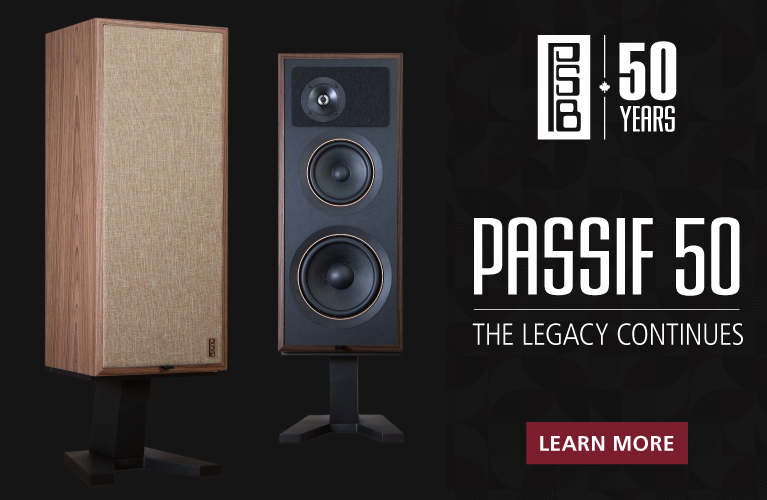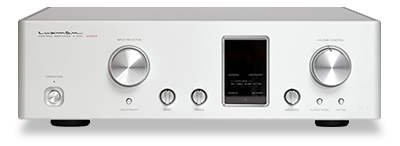
 When I went shopping for my first stereo, in 1981, the salesman encouraged me to buy, instead of something brand new, a six-year-old Luxman integrated amp that was on their used-equipment shelf. “For the price, it’ll be much better than what you can buy new today,” he said. But I wanted something new, so I went with a model from NAD, and wound up being quite happy with it. But I never forgot his recommendation of the Luxman amp and his reverence for the brand.
When I went shopping for my first stereo, in 1981, the salesman encouraged me to buy, instead of something brand new, a six-year-old Luxman integrated amp that was on their used-equipment shelf. “For the price, it’ll be much better than what you can buy new today,” he said. But I wanted something new, so I went with a model from NAD, and wound up being quite happy with it. But I never forgot his recommendation of the Luxman amp and his reverence for the brand.
Of course, there are those who have long had direct experience of Luxman products. The brand’s origins date back almost 90 years, to the Lux Corporation, founded in 1925 in Japan by two brothers, T. Hayakawa and K. Yoshikawa. Yet despite the brand’s age and my own awareness of it for 33 years, I’d never reviewed any of their products. Presented with the opportunity to review the M-900u power amplifier and the subject of this review, the C-900u preamplifier, I said yes. Each retails for $19,900 USD.
Description
Finding details about the Luxman C-900u (and M-900u) wasn’t as easy as it should be. The owner’s manual, a well-presented hardcover book, is entirely in Japanese, as was most of the information I found online. But through reading what little English material I could find -- sometimes by using an online translator for the Japanese -- I learned that the C-900u is a fully balanced design that, like the M-900u, uses the latest version (v.4.0) of Luxman’s Only Distortion Negative Feedback (ODNF) circuitry in conjunction with a Darlington circuit, which is claimed to reduce high-frequency distortion. The C-900u’s signal/noise ratio is a claimed 123dB via its single-ended outputs, or 126dB through the balanced ones. Both figures are very high, though no frequency range is specified.
The volume level is controlled by four Luxman Electric Controlled Ultimate Attenuator (LECUA) 1000s wired in parallel. Volume can be adjusted in 88 steps; as I discovered in listening, this was more than enough to find precisely the right listening level. There’s also a nod to the preamps of yesteryear: tone controls, which, despite their present scarcity, some listeners still find useful. According to Luxman’s literature, tone controls are very difficult to properly implement in a fully balanced design, due to the tight tolerances required. The circuitry for each channel is essentially doubled, and everything must be exactly matched, or more problems will be introduced than having the controls would solve. The C-900u’s balanced design means that balanced connections are the better way to connect it to source components and a power amp, and that’s what I did.
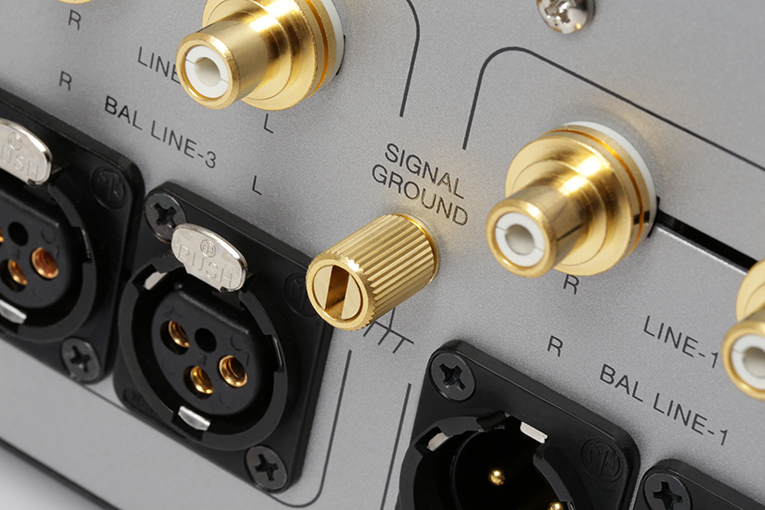
What the little available information doesn’t convey is the C-900u’s exceptional build quality, functionality, and beauty. The case, which measures 17.2”W x 5.1”H x 16.8”D, is made of thick aluminum slabs, flawlessly finished and meticulously assembled -- the seams align perfectly. The front panel is about 0.5” thick, whereas the sides, top, rear, and bottom are about 0.25” thick, which no doubt helps account for the C-900u’s substantial weight of 43 pounds. This heft is supported by sturdy cast-iron footers with cushioned undersides.
On the C-900u’s backside are three pairs each of single-ended (RCA) and balanced (XLR) inputs, two pairs each of single-ended (RCA) and balanced (XLR) outputs, one pair of single-ended (RCA) preamplifier inputs for an A/V processor or similar, a ground connector, an IEC-compatible power-cord inlet, two connectors for an external remote control, and a pushbutton for turning the main power on and off. All connectors are of top quality, and are well spaced to ease connections. Uniquely, plastic caps are supplied for any RCAs and XLRs that aren’t being used -- I’ve never seen that before, and it’s a nice touch. Also unusual is the high quality of the stock power cord -- usually, only a generic cord is supplied, or none at all.
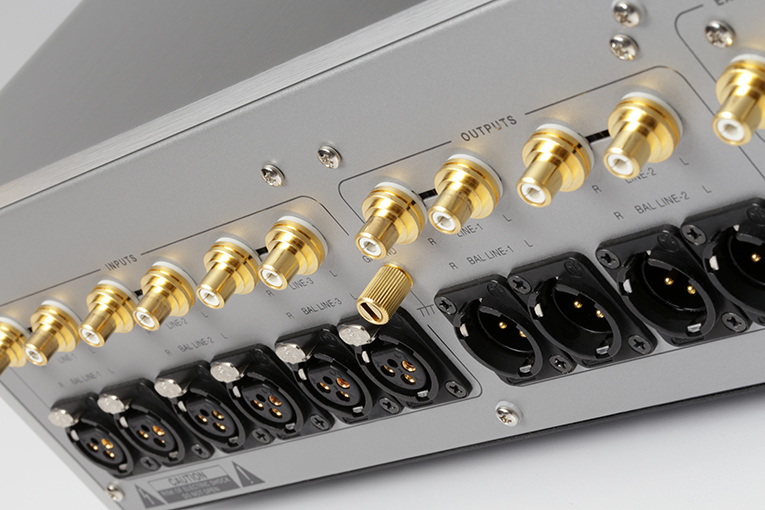
On the front panel are controls for: Operation, for daily turn-on/off; Input Selector, a large knob with a solid feel; the Bass and Treble tone controls, which operate respectively at 100Hz and 10kHz, to boost or cut up to 10dB at those frequencies; Line Straight, which bypasses the tone controls for the purest signal path; the Balance and Volume controls; Output Mode, which switches between the single-ended and balanced outputs; and Ext Pre, which works in conjunction with the preamp input on the rear panel. The controls are logically positioned and well spaced. I did most of my listening with Line Straight engaged, but I did test the tone controls’ effect and the transparency of their circuitry.
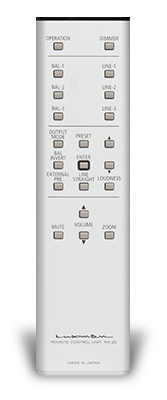 As attractive as it is unique is the front-panel display window of beveled glass, a great touch that looks almost jewel-like and wonderfully complements the metalwork. It displays the volume level, the input selected, etc., and reveals additional functionality available exclusively via the supplied remote control -- a compact, well-built little metal club.
As attractive as it is unique is the front-panel display window of beveled glass, a great touch that looks almost jewel-like and wonderfully complements the metalwork. It displays the volume level, the input selected, etc., and reveals additional functionality available exclusively via the supplied remote control -- a compact, well-built little metal club.
In addition to duplicating most of the front-panel controls, the remote has: Dimmer, which adjusts the display’s brightness or turns it off entirely; Loudness, which boosts certain frequencies for better audibility at low listening levels (it works, though I didn’t use it much); Balance Invert, which flips the polarity of the balanced outputs; Zoom, which shows the volume level in characters big enough to be read from across the room; Mute; and Preset, which took me forever to figure out -- mostly because the instructions were in Japanese, and I could find no online mention of it in English. Eventually, I figured out that two things can be configured with Preset. First, for each of the balanced connections, it can be used to make pin 3 hot and pin 2 cold, or vice versa. Depending how the balanced connections on your other components are configured, this can come in handy. Second, because the C-900u has two pairs each of balanced and single-ended outputs, it’s possible to use it to biamp your speakers without having to use splitters. With Preset, you can independently change the level of each set of outputs by +/-6dB -- basically, it acts as a balance control. Kudos to Luxman for covering all the bases; features like those last ones could come in handy. But why they’ve called this Preset is anyone’s guess.
Sound
My first inclination was to review the Luxman C-900u together with the M-900u, since they’re more or less companion pieces. But when I used the C-900u with Hegel Music Systems’ H30 power amp, also in for review, the sound was decidedly different from the sound with the M-900u, though still exceptional. I knew I’d be shortchanging the C-900u if I wrote about its sound quality only in the context of the Luxman amp -- it could easily be used with any super-high-quality power amplifier.
The first thing that became apparent was how quiet the C-900u was, no matter which amp I used it with -- slightly quieter, in fact, than the Simaudio Moon Evolution 740P ($9500) and EMM Labs PRE2 ($15,000) preamplifiers that I use as references, which themselves are very quiet. With my ear to a speaker’s tweeter, I could hear barely any hiss from the preamp.
Far more impressive was when I played some music -- the C-900u displayed the best combination of smoothness, neutrality, detail, transparency, and spaciousness that I’ve heard from any preamplifier, tubed or solid-state. Every recording I played through it sounded special in some way, and different from what I’d heard before -- I was always discovering something new. For instance, “Long Hard Road,” from Sade’s Soldier of Love (16-bit/44.1kHz FLAC, Epic), is hardly a reference-caliber recording -- it’s a highly produced, all-studio creation -- but I’d never heard Sade Adu’s voice so accurately positioned on the stage, or with such a sense of space behind her. The impressive depth was more apparent with the Luxman M-900u than with the Hegel H30, which has a much more upfront and immediate sound -- but regardless of which amp was in the chain, the kind of depth the C-900u could provide was nothing short of the state of the art.
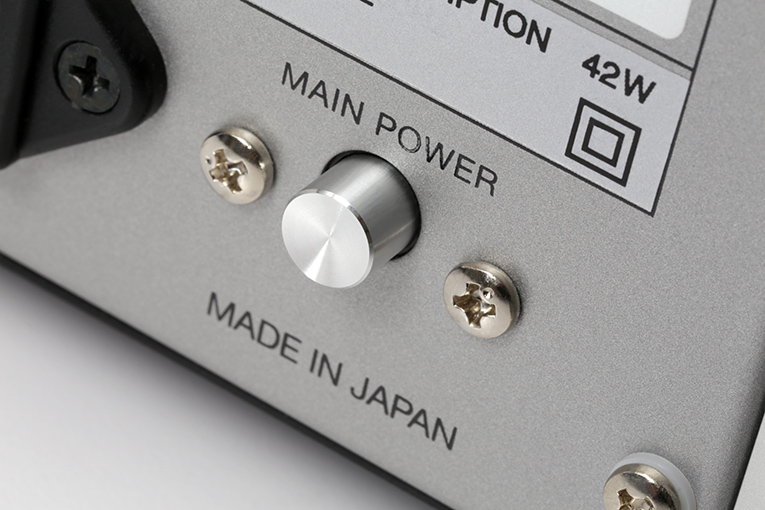
My tried-and-true reference recording for soundstaging and imaging, Ennio Morricone’s score for the film The Mission (16/44.1 FLAC, Virgin), is now almost 30 years old. Through the C-900u, it had as much detail as I’ve heard from it, and with so great a sense of cavernous space that my eyes opened wide. Sarah McLachlan’s EP The Freedom Sessions (16/44.1 FLAC, Nettwerk/Arista) is a pretty good test recording because it’s basically the raw tracks from the rehearsal sessions for her very successful Fumbling Towards Ecstasy, which doesn’t sound nearly as good -- too much postproduction, I suspect. The rawness of The Freedom Sessions lets me hear the EP’s better renditions of these songs -- such as “Elsewhere,” “Plenty,” “Good Enough,” etc. -- as well as the warts, whether mistakes in playing, or sounds that shouldn’t be there, or voices and instruments misplaced on the stage. Through the C-900u, all of that came through with reference-caliber clarity, detail, and transparency.
When it came to the frequency extremes, I applauded the C-900u’s ultradeep, tight, visceral bass, but was bowled over by how extended, effortless, and airy its highs were -- light as feathers. I also liked that, in my system, the C-900u’s sound combined state-of-the-art neutrality, detail, and transparency with what some call soul. Its sound wasn’t threadbare or lifeless, but had a tangibility that helped convey the feeling and emotion in whatever music I was playing. This trait is shared by the EMM Labs PRE2, and it’s one of the reasons I like that preamp so much; in contrast, Simaudio’s Moon Evolution 740P lacks a bit of that soul, and can sometimes sound just a touch sterile.
The C-900u had soul in spades. The other day, as part of a CD-ripping experiment I’ve written about for SoundStage! Global, I listened to Adam Cohen’s “Song of Me and You” umpteen-dozen times. Adam is Leonard Cohen’s son, and the song is from his latest release, We Go Home (16/44.1 FLAC, Resolute Music). When I played it through the C-900u, I was so smitten by the weight, presence, and authenticity of Cohen’s voice and guitar that, time after time, I forgot to critically listen -- I was absolutely drawn into his and his band’s performance. Ditto for Adam’s father’s latest album, Popular Problems (24/96 WAV, Columbia), a recording that’s a poster child for immediacy and presence -- Cohen’s deep, coarse, 80-year-old voice is miked ultraclose, which has long been the norm for his recordings, and with more than the usual amount of reverb added. All tracks are keepers, but right now my favorite is “Almost Like the Blues” -- the words are dark, as on Cohen’s The Future, but with a hint of Latin-pop rhythm in the percussion. In my system, Leonard Cohen’s voice was solidly planted center stage, tangible and weighty, and wonderfully contrasted with the angelic women’s voices spread around him -- when the women joined in, the C-900u’s feather-light highs were showcased in stark relief. What at amazing sound!
At this point in most of my reviews, I try to balance a product’s strengths with its deficiencies -- but I found no deficiencies in the Luxman C-900u. Music flowed from it in such a smooth, cohesive, natural way that the best thing to do is not criticize it, but highlight the one word that sums up its sound: faultless.
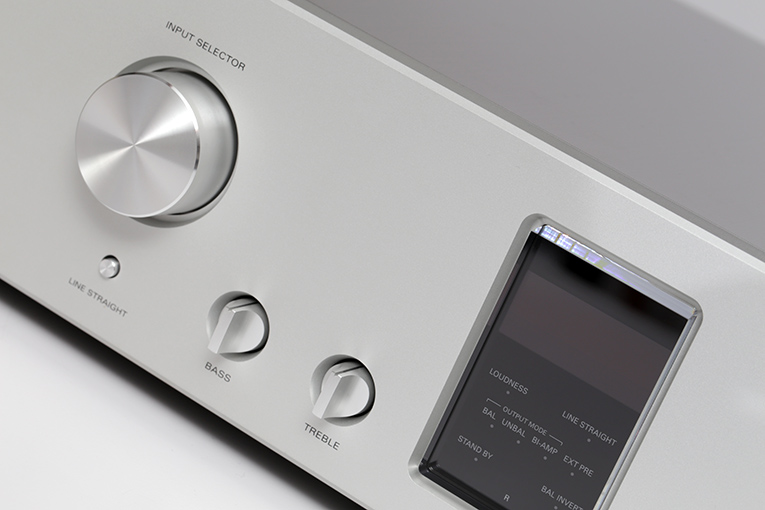
A sound so complete, authentic, and musically right meant that I had no need to fiddle with the tone controls. Still, there are good reasons someone might use them: to compensate for the flawed sound of another component in the system, the acoustics of the room, or a really bad recording. Many CDs released in the 1980s sound thin and bright -- the Treble control can be used to reduce the highs to an appropriate level. Likewise, if the speakers’ bass is overloading a room, reducing the low end with the Bass control might be welcome. There are myriad other reasons to tweak the highs and lows for the better -- it’ll depend on each situation.
But while I did no critical listening with the tone controls engaged, I did try them, and found that they work as advertised, subtly boosting or cutting the bass or highs when barely turned, or by quite a bit if I turned them all the way down or up. They can make a big change in the frequency extremes, if need be.
I tested the transparency of the tone-control circuits by setting them to flat, then switching on the Line Straight feature for the purest signal path, then off again to pass the signal through the tone controls. I could never reliably detect whether Line Straight was on or off. More telling were the times I thought Line Straight was on because I was reveling in the transparency and detail I was hearing, only to find out that it was actually off. I was surprised and impressed.
It’s for each listener to decide whether or not to use the tone controls -- each combination of listener, system, room, etc. is unique. If you don’t need them, set Line Straight and forget them. (And even if you forget to engage Line Straight, you’re likely to forget them.) If you need to use the C-900u’s tone controls, I’m confident you’ll reap only benefits.
Conclusion
The Luxman C-900u amazed me. It makes me wonder how different my audio journey might have been had I listened to that salesman 33 years ago and bought the used Luxman integrated he recommended. The C-900u’s build quality is outstanding, its styling is superb, and its unique feature set will be useful for those who need things such as tone controls and a Loudness contour.
But even if such features don’t float your audiophile boat -- and for many audiophiles, they won’t -- the C-900u’s sound will. It’s beyond reproach, even when compared with a topflight preamplifier with minimal controls. Incredibly detailed, stupendously spacious, and essentially flawless throughout the audioband, the C-900u did no wrong in my system and in my room. While I doubt I’d ever use its tone controls or Loudness contour, I’d be happy to own the C-900u as a sonic reference, and consider everything else it offers icing on a world-class cake.
I absolutely loved the Luxman C-900u. In my estimation, it’s a preamp for the ages -- and perhaps in a decade or two, it will have proven to be another classic from Luxman that will still be outperforming whatever’s new in 2024 or 2034.
. . . Doug Schneider
das@soundstagenetwork.com
Associated Equipment
- Speakers -- Revel Performa3 F206, Sonus Faber Olympica III
- Preamplifiers -- EMM Labs PRE2, Simaudio Moon Evolution 740P
- Amplifiers -- Hegel Music Systems H30, Luxman M-900u
- Digital-to-analog converters -- EMM Labs DAC2X, Simaudio Moon Evolution 650D
- Computer -- Samsung laptop running Windows 7 and JRiver Media Center 18
- Digital interconnects -- AudioQuest Carbon USB
- Analog interconnects -- Crystal Cable CrystalConnect Standard Diamond
- Speaker cables -- Siltech Classic Anniversary 330L
Luxman C-900u Preamplifier
Price: $19,900 USD.
Warranty: Five years parts and labor.
Luxman Corporation
222-0033 Yokohama
1-3-1 Shin-Yokohama Kouhoku-ku
Japan
Website: www.luxman.com
North American distributor:
Luxman America Inc.
27 Kent Street, Suite 122
Ballston Spa, NY
12020
USA
Phone: (518) 261-6464
E-mail: info@luxmanamerica.com






















